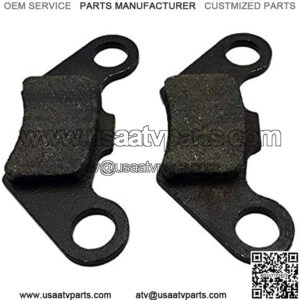Thin brake pads can compromise your vehicle’s performance, and more importantly, they can compromise your road safety.
That’s why you must make it a habit to check your brake pads’ condition regularly.
To help you out, here are a few noticeable things that can warn you of thin brake pads:
1. You Hear Noises When Braking
If you hear a high-pitched squealing or groaning noise from the tires whenever you brake, chances are, your brake pads need replacement.
Usually, modern brake pads have little metal tabs that come in contact with the rotor when 75% of the brake pad has worn out. The metallic grinding sound is a sign that your friction material has severely deteriorated and that you must replace the brake pads soon.
What happens when the metal tabs fade?
Once these metal tabs fade, the brake pads’ backing plate eventually starts grinding on the discs, damaging them.
This usually generates brake dust that sticks to your car’s wheels — which is another easy-to-spot sign that your pads need replacing.
2. Your Brake Warning Lights Are On
Some cars have a built-in dashboard indicator light that lights up when your brake system is compromised.
It’s important to note that this warning light is for your entire braking system — it isn’t just a brake pad indicator.
Your warning light could be notifying you of anything, from an engaged parking brake, to the car running low on brake fluid. However, it could also indicate that you have a worn brake pad.
To be safe, when in doubt, consider checking all of your brake components whenever the warning light flashes.
3. Your Car Veers To One Side When Braking
At times, your car’s brake pads might wear out unevenly.
This might result in your car veering off to one side whenever you apply the brakes.
This happens because the brake material on one side of your car is far thinner than the other — resulting in lower stopping power on that side. As a result, whenever you apply the brakes, your vehicle will veer off in that direction as there’s not enough friction in place.
It’s important to note that even if you’re facing brake thickness issues on just one side of your car, you should always replace your brake pads in pairs.
For example, even if just one of your rear brake pads needs replacement, you must change both the pads on your rear axle. Changing these rear pads in pairs ensures that they remain evenly thick and provide consistent braking performance.
How To Inspect Brake Pad Thickness
Checking your pad thickness from time to time can help you avoid brake failure and unsafe driving conditions.
While you can conduct a visual inspection of brake thickness on your own, we don’t recommend it as you have to be very careful to ensure nothing goes wrong.
Additionally, you might need specific tools such as a brake pad measuring gauge.
So it’s always a good idea to get a professional to do it for you.
However, if you don’t have access to a professional and urgently need to check your brake pad thickness, follow these steps:
Step 1: Park your car on a level road.
Step 2: Use a jack to slowly elevate the side of your car you want to examine. Your owner’s manual should indicate the best position to place the jack.
Step 3: Use a lug wrench to loosen and remove the bolts on the wheel.
Step 4: Carefully remove the wheel to expose the brake rotor and caliper (the piece that houses the brake pad).
Step 5: Look into the hole in the caliper, and you can see both the inboard pad (or inside pad) and outboard pad (or outer pad).
Step 6: Measure the thickness levels of your brake pads with a brake measuring gauge, Vernier caliper, or compass.
If your pad thickness is less than the minimum thickness of 3.2 mm, opt for an immediate replacement.
Thicker Brakes = More Safety
Your brake pad is a critical part of your car’s brake system that generates the necessary friction to slow down and ultimately stop your vehicle.
However, over time, your brake pads will start to wear out.
And when your brake pads are thinner than 3.2 mm (⅛ inches), they’re no longer reliable.
About Brake Pad
“brake pad replacement cost”
“brake pad replacement”
“brake pad”
“brake pad thickness”


